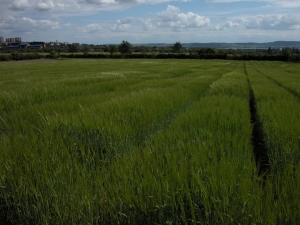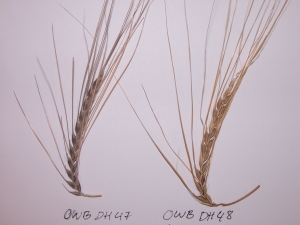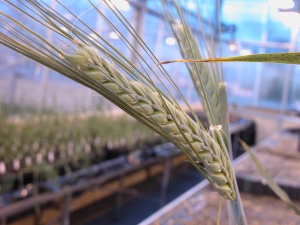


Barley (Hordeum vulgare L.)

|

|

|
Barley is the fourth most important cereal plant in the world based on its production (2005 FAO data for Europe
 and world
and world
 ). Cultivation area of barley in Northern hemisphere ranges from Polar circle to Northern Africa. Barley is grown on all continents except Antarctica. Primary uses for barley include animal feed, human food and malt production for beverage industries.
). Cultivation area of barley in Northern hemisphere ranges from Polar circle to Northern Africa. Barley is grown on all continents except Antarctica. Primary uses for barley include animal feed, human food and malt production for beverage industries.
Barley is considered to have been the first plant species domesticated by Neolithic tribes approximately 10,000 years ago (Harlan and Zohary 1966). Archeological excavations in early Neolithic sites in Israel have uncovered that wild barley was gathered for human food as early as 23,000 years ago (Weiss et al. 2004).
Barley (Hordeum vulgare L.), wheat (Triticum aestivum L.) and rye (Secale cereale L.) belong to the tribe Triticeae within the grass family Poaceae, where other important agricultural plant species are included, e.g., rice (Oryza sativa L.), maize (Zea mays) and oats (Avena sativa L.). Barley belongs to genus Hordeum, along with other 32 species. Cultivated barley Hordeum vulgare ssp. vulgare was domesticated from its wild relative Hordeum vulgare ssp. spontaneum (C.Koch) Thell., which is still found in its wild habitats in the Near East (Afganistan, Iraq, Iran, Israel, Jordan, Kyrgyzstan, Lebanon, Pakistan, Syria and Turkey). Images of wild relatives of barley, wheat and oat can be found here.
Barley is diploid (2n = 2x = 14) self fertile inbreeding plant with genome size roughly 5.3 billion base pairs (Bennet and Leitch 1995). Barley was used as a model organism in investigations that formed basis for population and evolutionary genetics (Allard 1999). The genomes of barley and other Triticeae species are colinear allowing to extend the knowledge of barley genome to other species. Thus, understanding the structure of barley genome facilitates our studies of genomes of other Triticeae species, e.g., hexaploid wheat with estimated genome size of 16 billion base pais.
Rich genetics and genomics resources are available for barley. There are many linkage maps that contain several thousands of molecular and morphological markers (GrainGenes data base). Various ex situ gene banks and repositories contain an estimated number of 485,000 barley accessions (FAO 1996). These diverse wild barley, landrace and cultivated forms present a rich gene pool for future barley breeding. Extensive barley mutant collections exist serving as a tool for identification of gene function, as well as a potential source for breeding barley varieties with novel characteristics. There are more than 400,000 barley Expressed Sequence Tags available, which identify a large proportion of barley gene space. Map-based cloning in barley is facilitated by availability of genomic Bacterial Artificial Chromosome library (Yu et al. 2000). EST Unigenes were used to design the first Affymetrix microarray for a crop plant (Close et al. 2005; www.affymetrix.com). Affy chip has been used extensively to create publicly available gene expression and genotyping data sets that allow to follow patterns of gene expression throughout the barley development (Druka et al. 2006) simultaneously uncovering genetic diversity (Rostoks et al. 2005; Cui et al. 2005). A structured barley mutant population has been created as a reverse-genetics tool (Caldwell et al. 2004). Studies of natural genetic variation within barley germplasm identified several thousand sequence-verified SNPs (Rostoks et al. 2005, SCRI SNP data base) and many more EST-based electronic SNPs (Close et al. unpublished). Barley SNP were used to establish a high-throughput SNP genotyping platform based on Illumina technology (Rostoks et al. 2006). Availability of rich barley genomics resources formed basis for European Triticeae Genomics Initiative (ETGI) that aims to create physical genome map of barley and wheat with a long-term ambitious goal to determine genome sequence of barley and wheat.
Recommended reading
Diversity in barley (2003) von Bothmer R, van Hintum T, Knüpffer H, Sato K eds. Elsevier, Amsterdam, The Netherlands, 280 p.